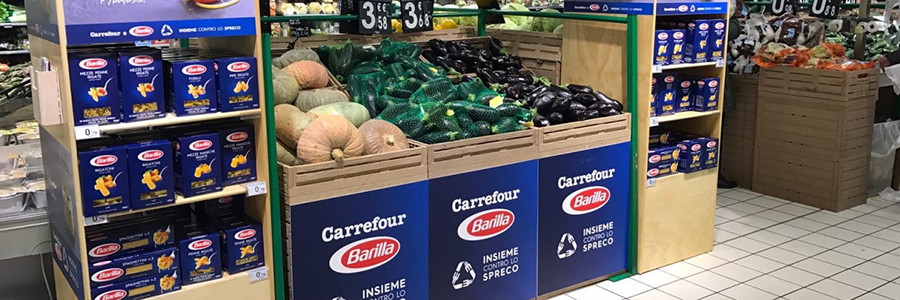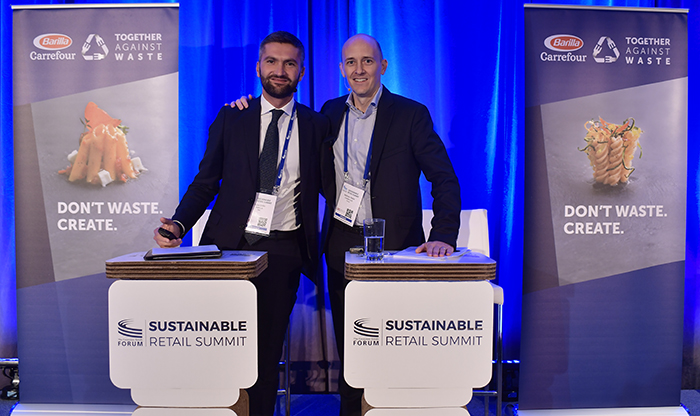Food loss and waste (FLW) represents one of the most significant social, economic, and environmental issues facing our planet. At a time in history where nearly one billion people are still dying of hunger or have to settle for inadequate nutrition every year, it is unacceptable that over a third of the world’s food remains abandoned in fields or ends up in landfills. From an environmental perspective, food loss and waste generates about 8% of global greenhouse gas emissions. If it were a country, FLW would be the third-largest greenhouse gas emitter, behind China and the United States. It has recently been shown that reducing food waste around the world would help curb emissions of planet-warming gases, lessening some of the impacts of climate change such as more extreme weather and rising seas. We as food companies must be aware of these impacts and promote not only initiatives that encourage consumers not to waste the food they buy, but also do our best to reduce FLW along our food supply chains.
102017 Barilla Carrefour LogosArmed with insight from studies carried out by the Barilla Center for Food & Nutrition Foundation, and in line with our long-standing slogan “Good for You, Good for the Planet”, Barilla has started to analyse three of its supply chains (pasta, tomato sauce and bread) in collaboration with Last Minute Market (LMM), a spin-off from the University of Bologna. Our goal is to monitor food loss and waste all along the value chain, identifying the causes and measures to reduce them. The reference standard used for these analyses is the Food Loss and Waste Accounting and Reporting Standard (FLW Standard), which is a global standard that provides requirements and guidance for quantifying and reporting on the weight of food and/or associated inedible parts removed from the food supply chain. This standard enables countries, cities, companies and other entities to develop inventories of how much FLW is generated and where it goes.
An example of the FLW Standard at work can be seen in how we measure food loss and waste connected to our Barilla Blue Box Pasta. We considered the key ingredients – semolina and pasta produced in Italy – and analysed all loss and waste along the entire life cycle, from farm to fork. The study began in March 2016 and ended in December 2016. The total weight of the FLW has been quantified in 1.98 kg for 1 kg of pasta produced. However, the total includes all food (0.33 kg) and the inedible parts (1.65 kg). “Food” refers to any substance—whether processed, semi-processed or raw—that is intended for human consumption. “Inedible parts” refer to components associated with food that—in the food supply chain—is not intended to be consumed by humans. In this study, we chose to include all edible and inedible parts in our FLW, and the overall results are clearly influenced by the inedible parts. This is highlighted further when we look closer at the data:
- At the production stage, we have almost 50% of straw losses.
- Along the supply chain, 83% of all FLW consists of inedible parts, mainly related to physiological issues, such as straw (66%) and a small part during milling and pasta production stages.
- Only 17% are considered edible parts: mainly wasted in the consumption stage (76% of all edible parts).
87% of all FLW can be found in the early stages of the supply chain, up to the point of distribution and 13% in the final stages – distribution and consumption phases. - However, we must note that we lose most edible parts at the consumption level (76%).
- The interesting aspect is that 94% of the total FLW measured along the pasta production is used in alternative sectors, while only 6% is destined for landfill disposal.
- Of the 94% of FLW that doesn’t go to landfill, 40.3 % is used for animal feed and care, 25% is not harvested, 22% is recovered for energy, 6% is composted, and 0.07% is used for human consumption.
In conclusion, it has been found that this supply chain is an example of a true circular economy, where almost nothing is lost. Food loss in the field is very limited (less than 2% due to grain losses), while the straw obtained during the harvest—weighing the same as wheat—is usually used as animal feed and for litter. Loss generated during the grinding of the grain and the pasta production amounted to around 2%.
However, the research carried out has shown that the greatest waste is concentrated in the consumption phase. In fact, according to this research, the product wasted at the final level (household and hospitality sectors) amounted to between 10% and 40%, especially in school catering with an average value of 25%. According to a study conducted in 2013 by LMM on domestic waste in the Italian households, dry pasta is the least wasted product in domestic contexts, while cooked pasta is the most wasted product among cooked food. Therefore, on the one hand, pasta is an easily preserved food, easily manageable in domestic contexts; but, on the other hand, it is the most wasted product when cooked, as it is often prepared in excessive portions that end up not being consumed.
In addition to this project, we at Barilla are also committed to nudging our consumers not to waste food, while encouraging healthy eating behaviours. To this end, we partnered with Carrefour on a project to encourage their customers to think about making a pasta dish with vegetables that they might otherwise throw away. The call to action “don’t waste, create”, seeks to motivate our consumers to use their creativity like a top chef in order to make healthy and delicious dishes with pasta and leftover vegetables.
The project has an international scope and involves many touchpoints (both physical and digital), even though the main touchpoint is within the Carrefour stores. A variety of recipes have been developed by the Barilla Chef Unit to help people avoid wasting food in their homes.
Luca Cirillo, Barilla and Matthew Mellin, Carrefour at this year’s Sustainable Retail Summit in Montréal.
Luca Cirillo
Key Account Manager
BARILLA



